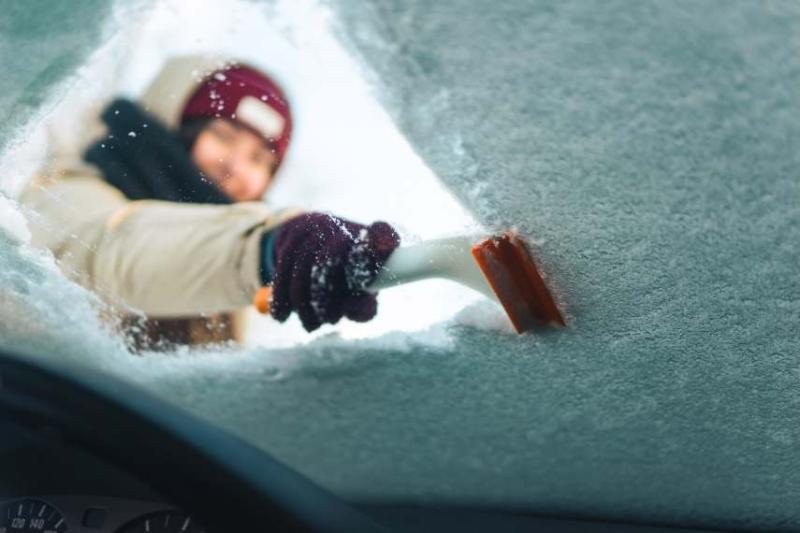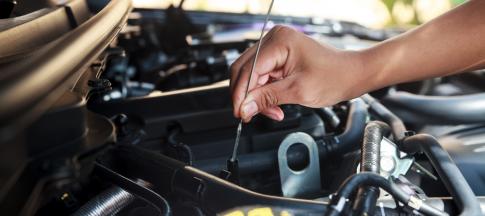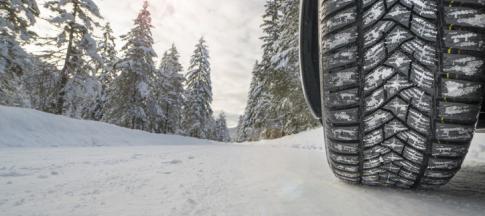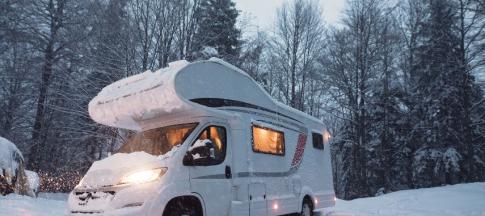
Driving in winter can be challenging thanks to slippery roads and poor visibility that can impact your driving and insurance.
However, you can help to reduce your risk of an accident or a breakdown by giving your car a winter health check. Below is our 10-point action plan to prepare your car for winter.
1. Check tyre tread depth
Worn tyres increase your chances of skidding, aquaplaning and being in an accident. They can also result in fines of up to £10,000 (£2,500 per tyre) and 12 penalty points.
Legally, the tread depth must be at least 1.6mm. However, experts recommend a depth of 2-3mm.
There are a few ways to check the tyre tread depth, including tread depth gauges, tyre tread indicators and various tools in professional garages.
We recommend the 20p test:
- pump each tyre up – the test doesn’t work if they’re flat
- place a 20p into the groove of a tyre
- if you can’t see the coin’s outer band, your tyres are above the legal limit
- if you can see the coin’s outer band, they’re below the limit and need replacing
We have a handy video guide on checking tyre tread and pressure if you'd like to learn more.
You can also choose winter tyres if you live in a cold climate. They have deeper treads and softer rubber, providing more traction.
Read more about winter tyres.
2. Check coolant levels regularly
Coolant cools down your engine, prevents rust and stops freezing. It’s a mixture of antifreeze and water.
It’s always good for your car, but it’s essential in sub-zero temperatures. You should regularly check your engine’s coolant level and replenish it when needed.
Only try to change the coolant when the engine is off, or you’ll burn yourself.
The ideal coolant level is between the min/max in the tank but check your car’s user manual. You need a protection level of at least -25°C.
Use out our video guide to checking engine coolant if you'd like to do it yourself.
3. Maintain your lights and use the correct ones
Visibility is difficult in winter, so you need reliable, well-maintained lights. You should visually check your vehicle’s lights regularly and if a light’s out, replace it before making your next journey.
We have a useful video tutorial on checking and changing your car's lights if you'd like to learn more.
Legally, all your car's exterior lights must be operational – that's everything from the headlights to indicators and even the number plate bulb.
This is when to use your different lights:
- dipped headlights – dusk, night and in poor visibility
- high or full beam – when conditions are poor
Turn your high or full-beam headlights back to dipped if you see another driver as the bright lights can obscure their view of the road.
The days are shorter in winter, so night-time driving is more common. Read our guide on driving at night for more advice.
4. Check your wipers
In winter, your windscreen can get dirty much quicker from rain, ice, salt and muddy water. This means having working wipers and filled windscreen wash is important.
If your wipers are faulty or windscreen wash is empty, you can be stopped by the police for a few motoring offences. Having faulty wipers/blades is also a common reason for an MOT failure.
Avoid this by:
- making sure your wiper blades are clean and don’t leave smears/streaks
- running your fingers along the wipers to check for splits
- not using washing-up liquid in your washer reservoir
- using washer fluid that can withstand temperatures of at least -15°C
Experts recommend you change wiper blades every 12 months.
Check out our guide on changing windscreen wipers if you think your wipers need replacing.
5. Review your windscreen’s condition
Make sure your windscreen isn’t likely to chip or crack. This is more likely to happen in winter when you de-ice your car windscreens.
We deal with thousands of windscreen claims yearly, and windscreen protection is a key part of most car insurance policies.
Some things you can do to avoid windscreen damage:
- check the weather – use a windshield if overnight frost is forecast
- clear frost slowly – use de-icer and scrape slowly when your windscreen is frosted
- avoid using boiling water – it can cause cracks or chips
- maintain wipers – worn wipers can also reduce visibility in snow and rain
6. Monitor engine oil
Motor oil behaves differently at very cold temperatures, and it doesn’t flow as well. Your engine may take longer to heat up or run inefficiently because of this..
To avoid engine damage and a potential breakdown, check your engine dipstick regularly and keep the oil topped up. Remember: too little or too much oil can cause engine problems.
Aim to change your oil and filter every year (usually at the annual service), and don't ignore any warning signs. Left ignored, your engine will seize up and could cost thousands to rebuild or replace.
Keep an eye out for leaks too. Losing oil too quickly and seeing dark puddles under your car are signs that you have a leak. Common causes of engine leaks include:
- a damaged oil filter
- a failing filter cap
- leaking oil pan gasket
- broken valve cover
- too much oil
Contact a professional if you aren’t comfortable finding the leak’s source.
Lastly, check your car’s manual to make sure you’re buying the correct oil type and buy a reputable brand.
If you want to check and top up your engine oil, our video guide may be useful for you.
7. Test your brakes
Your brakes can help prevent aquaplaning and skidding in the winter.
Some garages and tyre fitters carry out free brake tests where the technicians check your car’s brake pads, shoes, callipers, hoses, discs and handbrake linkages.
We recommend testing your brakes at a professional garage. Here are some common signs of brake damage:
- loud or squeaking noises when braking
- spongy or soft brakes
- a burning smell when braking
- your brake light flashes when the brakes aren’t applied
- If you notice any of these, get your brakes tested.
8. Test your battery
Flat batteries are a common fault in winter. Drivers use heaters, demisters and lights more in cold, dark weather, causing strain on the battery.
We also drive shorter distances more often in winter to avoid getting caught in the rain, meaning the engine and alternator struggles to recharge the battery.
As part of your car’s winter health check, get a professional to test your battery. You may want to buy a battery charger and jump leads too.
9. Top off the bodywork
Salt and grit help keep roads running, but they can increase rust and corrosion on your car.
The only way to stop this is through prevention. Wash and wax your car before the weather gets bad, paying attention to the wheel arches and underside.
This should keep your car in good shape over the winter and prevent long-term damage.
10. Have the right insurance
Are you as covered as you could be? If your renewal is before winter, then consider your car insurance cover level.
Our cover includes features like breakdown cover, and windscreen cover on comprehensive cover (excluding the Essential tier).
It’s often more beneficial to have far-reaching cover, and should an accident happen, you’ll have the right level of protection.
What if I don’t have time for a winter health check?
Head to your local garage or tyre fitter if you don’t have time to carry out the above – many offer special winter checks.
However, that costs money – if you can’t do all the above, we recommend prioritising your tyres and visibility.
Read our tips for driving in extreme weather to stay prepared, too.
I'm an experienced journalist, digital editor and copywriter, now specialising in motoring. I’m editor of Automotive Blog and have worked across the media in newspapers, magazines, TV, teletext, radio and online for household names including the BBC, GMTV, ITV and MSN. I’ve produced digital content in the financial sector for Lloyds Bank, Nationwide and the Money Advice Service. I'm married with two children and live near Bath in Somerset.



